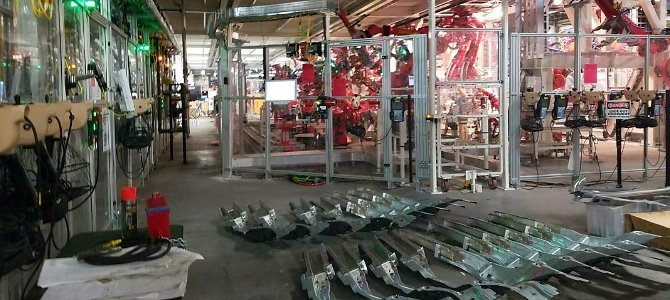
Tesla has been vague about its reasons for missing its first full-quarter Model 3 production goals by more than 80%, blaming “bottlenecks” for the delay and “emphasizing” that “there are no fundamental issues with the Model 3 production or supply chain.” But according to a source familiar with the development and deployment of the Model 3 production system, Tesla’s rushed and disorganized approach made the current “production hell” inevitable.
At the outset of the Model 3 program, Tesla asked a major automated tooling supplier to develop two Body In White (BIW) transfer lines for the Model 3. The source, who spoke on condition of anonymity for both himself and the supplier, says disagreements between Tesla’s designers and engineers resulted in numerous revisions to the scope of the contract and eventually led Tesla to drop the second line from its purchase order (PO).
“Tesla was in disarray when it came to knowing what they wanted,” the source tells Daily Kanban. “Manufacturing engineers were pressuring us to work on a design that was not yet approved.” Turnover in key positions at Tesla contributed to the chaos, as lessons learned during previous work on the joint Model S/X production line were lost with departing employees.
Despite Tesla’s public claims that the Model 3 would be “designed for production,” disagreements between its own designers and engineers contributed to five revisions to the Model 3 line design before a PO was even signed. At least four more revisions came after the PO was signed, forcing Tesla to pay extra for delivery on a compressed timeline. Even with these delays, the supplier was ultimately able to deliver on Tesla’s timeline.
In addition to the compressed deadline and high volume of design revisions, the Model 3 practice diverged from standard industry practice in that it was a so-called “cold build.” Typically, equipment suppliers build the line at their facility, where it is thoroughly tested up to its nominal jobs-per-hour (JPH) specification. When it is ready, it is dismantled, and shipped to the assembly plant for installation. Once installed, thorough testing and tweaking is required. This testing and tweaking phase should take around 6 months, more conservative automakers test the line for up to a year before it starts making cars to be sold.
The “cold build” approach that Tesla took with the Model 3 BIW transfer line skips the supplier testing step, meaning the line was shipped to Fremont for installation at Tesla’s plant without having been validated, the source said.
Because of the compressed timeline and “cold build,” Tesla’s first Model 3 line will likely require more debugging than usual and could even require post-installation modification. That work must all take place at Fremont, requiring Tesla to pay for travel and overtime for the supplier’s highly skilled engineers. That installation and debugging work is ongoing according to the source, who confirms that Tesla has not yet built a Model 3 using the automated tooling.
For comparison, this same supplier built a line for a major automaker’s 2020 model-year product. That project was started a year before work began on the Model 3 line and it was built, tested, disassembled and shipped to the factory before the supplier even started shipping elements of the Model 3 transfer line. That product is currently in validation/pre-production testing and will not become available until the second half of next year. According to the source, automakers avoid “cold builds” and compressed timelines because “when something goes out into the field bad, the cost to bring it up to snuff is way more than if you paid to have it done right the first time.”
The Wall Street Journal has reported that Model 3 body line equipment was still being installed in September and that calibration would likely continue into October. City of Fremont records show new Tesla permit applications for Model 3 BIW and General Assembly equipment being filed, revised and even disapproved through the last full week of October.
Work on the the second Model 3 line, which the tooling supplier had originally planned to build and install in the second half of this year, has not yet begun. The supplier has been told that there is not enough room at the Fremont plant to install the second line, which was supposed to double Tesla’s Model 3 production capacity. It is not clear how or when Tesla will find the room for the second line.
Wards Auto has reported that Tesla needs a second body shop, in order to support the production volumes that CEO Elon Musk has forecast. “I understand they’re talking about a second body shop,” a “source in position to know” told Wards, “but I can’t see them reaching 2,500 to 3,000 weekly until the end of next year.”
Tesla has not responded to Daily Kanban’s repeated requests for comment.





